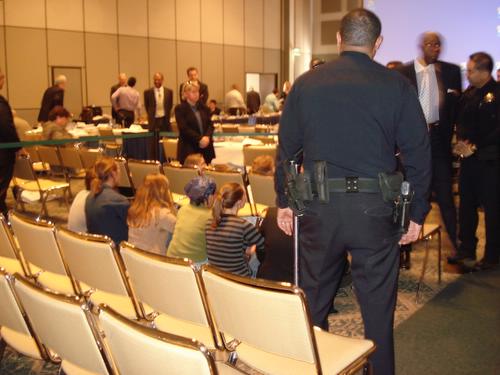Kofi Annan: End “Mutually Assured Paralysis”
John Burroughs
Along with other NGO representatives, I had the opportunity the other evening to say a few words at a reception here in New York honoring Kofi Annan, who will step down as UN Secretary-General at the end of this month. Speaking on behalf of the Lawyers’ Committee on Nuclear Policy and the International Association of Lawyers Against Nuclear Arms, I had no difficulty being utterly sincere. I started by thanking him for his condemnation of the U.S. invasion of Iraq as contrary to the UN Charter. I went on to say how much we appreciate his eloquent, informed and incisive calls for progress towards elimination of nuclear weapons, most recently in a remarkable speech at Princeton.
The speech is a clear exposition of the need for simultaneous action on two linked fronts: to prevent the spread of nuclear weapons and technologies for their production, and to marginalize and eliminate existing arsenals. Referring to the debate between proponents of “non-proliferation first” (mostly nuclear weapon states and their supporters) and proponents of “disarmament first,” Annan said:
“each side waits for the other to move. The result is that ‘mutually assured destruction’ has been replaced by mutually assured paralysis. This sends a terrible signal of disunity and waning respect for the [Non-Proliferation] Treaty’s authority. It creates a vacuum that can be exploited.”
Later, Annan observes that it is not clear how the NPT-acknowledged nuclear weapon states (Britain, China, France, US, Russia)
“propose to deal with the four nuclear-weapon-capable States [India, Israel, North Korea, Pakistan] outside the NPT. They warn against a nuclear domino effect, if this or that country is allowed to acquire a nuclear capability, but they do not seem to know how to prevent it, or how to respond to it once it has happened. Surely they should at least consider attempting a ‘reverse domino effect’, in which systematic and sustained reductions in nuclear arsenals would devalue the currency of nuclear weapons, and encourage others to follow suit.”
Annan’s central proposal is this:
“I call on all the States with nuclear weapons to develop concrete plans — with specific timetables — for implementing their disarmament commitments. And I urge them to make a joint declaration of intent to achieve the progressive elimination of all nuclear weapons, under strict and effective international control.”
Most of what Annan says has been said repeatedly before, in international forums at least. But he says it very, very well, and as the Secretary-General he can put the truisms of those forums before the global public. There are a few points in his remarks that stretch the boundaries of current discussions around the UN, or the NPT, and even the report of the WMD Commission. The one I want to highlight is this:
“States that wish to discourage others from undertaking nuclear or missile tests could argue their case much more convincingly if they themselves moved quickly to bring the Comprehensive Nuclear-Test-Ban Treaty into force, halt their own missile testing, and negotiate a robust multilateral instrument regulating missiles. Such steps would do more than anything else to advance the cause of non-proliferation.” [Emphasis supplied.]
It is absolutely correct that stopping proliferation and beyond that progress on elimination of nuclear arsenals will require paying very serious attention to delivery systems. That is something we, especially Andrew Lichterman, have been saying on this blog and elsewhere, but since the high water mark of disarmament discussions in the mid-1990s, it has basically receded from view. So Annan is to be congratulated for helping to bring it back into view.
One last thing: Don’t miss Zia Mian’s superb piece in the Daily Princetonian taking Annan’s speech as a starting off point for a meditation on the challenges of planning for and achieving the end of the nuclear age.












